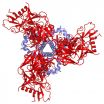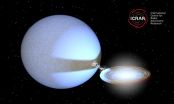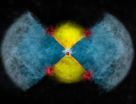Researchers develop reproducibility score for SNPs associated with human disease in GWAS
New model predicts replication rate in genome-wide studies based on SNP characteristics
2014-10-08
(Press-News.org) Lebanon, NH, 10/8/14 —To reduce false positives when identifying genetic variations associated with human disease through genome-wide association studies (GWAS), Dartmouth researchers have identified nine traits that are not dependent on P values to predict single nucleotide polymorphisms (SNP) reproducibility as reported in Human Genetics on October 2, 2014.
Reproducibility rates of SNPs based solely on P values is low. Dartmouth authors' analysis of GWAS studies published in Nature Genetics showed a 1-5 percent replication rate.
"It is important to improve our ability to select SNPs for validation using a formalized process. In this paper, we propose a combination of traits that improve replication success," said first author Ivan P. Gorlov, PhD, DSC, associate professor of Community and Family Medicine, Geisel School of Medicine at Dartmouth.
The team assigned a value of zero or one to nine different predictors. To compute the Replication Score (RS), one totals the individual scores for all significant predictors. The predictors include "Online Mendelian Inheritance in Man" (OMIM, a list of genetically caused diseases), receptors, kinases, growth factors, transcription factors, tissue specific, plasma membrane localization, nuclear localization and conversation index. The authors provided detailed information to construct the RS in supplementary material to the paper.
An RS score is not disease specific but shows the potential for impact on human disease. "The disease-associated genes have something in common," said Gorlov. "And we know what specific characteristics should be present to ensure the SNP is likely to be replicated"
Gorlov says the empirical model can be used to select SNPs for validation and prioritization. "We believe that RS-based SNP prioritization may provide guidance for more targeted and powered approach to detecting the disease-associated SNPs with small effect size," he concluded.
INFORMATION:
This work was supported in part by the National Institutes of Health U19 CA148127 Grant and the National Institutes of Health Grants 5 P30 CA016672, LM009012, LM010098 and GM103534. The funders had no role in study design, data collection and analysis, decision to publish, or preparation of the manuscript
About Norris Cotton Cancer Center at Dartmouth-Hitchcock
Norris Cotton Cancer Center combines advanced cancer research at Dartmouth and the Geisel School of Medicine with patient-centered cancer care provided at Dartmouth-Hitchcock Medical Center, at Dartmouth-Hitchcock regional locations in Manchester, Nashua, and Keene, NH, and St. Johnsbury, VT, and at 12 partner hospitals throughout New Hampshire and Vermont. It is one of 41 centers nationwide to earn the National Cancer Institute's "Comprehensive Cancer Center" designation. Learn more about Norris Cotton Cancer Center research, programs, and clinical trials online at cancer.dartmouth.edu.
ELSE PRESS RELEASES FROM THIS DATE:
2014-10-08
A new study from UCLA found that a drug being evaluated to treat an entirely different disorder helped slow the progression of Parkinson's disease in mice.
The study, published in the October edition of the journal Neurotherapeutics, found that the drug, AT2101, which has also been studied for Gaucher disease, improved motor function, stopped inflammation in the brain and reduced levels of alpha-synuclein, a protein critically involved in Parkinson's.
Although the exact cause of Parkinson's is unknown, evidence points to an accumulation of alpha-synuclein, which has ...
2014-10-08
Astronomers working with NASA's Nuclear Spectroscopic Telescope Array (NuSTAR), led by Caltech's Fiona Harrison, have found a pulsating dead star beaming with the energy of about 10 million suns. The object, previously thought to be a black hole because it is so powerful, is in fact a pulsar—the incredibly dense rotating remains of a star.
"This compact little stellar remnant is a real powerhouse. We've never seen anything quite like it," says Harrison, NuSTAR's principal investigator and the Benjamin M. Rosen Professor of Physics at Caltech. "We all thought an ...
2014-10-08
ATLANTA – October 08, 2014 – A study from American Cancer Society researchers finds the increased risk of premature death associated with a higher body mass index (BMI) is similar for African Americans and whites, in contrast to previous, smaller studies that indicated the association may be weaker for African Americans. The study, published in the open-access, online publication PLOS ONE, finds that among never smokers without prevalent disease, overweight and obesity are strongly associated with subsequent risk of mortality in every race. The authors say ...
2014-10-08
New Haven, Conn. - HIV is adept at eluding immune system responses because the protein it uses to infect cells is constantly changing.
Now a team of researchers including scientists from Yale have stripped the cloak from this master of disguise, providing a high resolution image of this surface spike protein and monitoring how it constantly changes its shape, information that suggests new ways to attack the virus through drugs and vaccines.
In two papers published simultaneously online Oct. 8 in the journals Science and Nature. team of researchers led by scientists ...
2014-10-08
Highly-detailed radio-telescope images have pinpointed the locations where a stellar explosion called a nova emitted gamma rays, the most energetic form of electromagnetic waves. The discovery revealed a probable mechanism for the gamma-ray emissions, which mystified astronomers when first observed in 2012.
"We not only found where the gamma rays came from, but also got a look at a previously-unseen scenario that may be common in other nova explosions," said Laura Chomiuk, of Michigan State University.
A nova occurs when a dense white dwarf star pulls material onto ...
2014-10-08
New research has illuminated the movement and complete structure of the spikes on HIV that the virus uses to bind to the cells it infects. This research, led by scientists at the National Institutes of Health, Weill Cornell Medical College and Yale University School of Medicine, could help advance efforts to develop HIV vaccines and treatments.
Three sets of a pair of molecules called gp120 and gp41 constitute each HIV spike, which adopts different configurations before and after the virus fuses with a cell. The atomic-level structures of pre-fusion gp120 and post-fusion ...
2014-10-08
NEW YORK — (October 8, 2014) -- Researchers at Weill Cornell Medical College have developed technologies that allow investigators, for the first time, to watch what they call the "dance" of HIV proteins on the virus' surface, which may contribute to how it infects human immune cells. Their discovery is described in the Oct. 8 issue of Science, and is also a part of a study published the same day in Nature.
The new technology platform opens new possibilities for devising an approach to prevent HIV infection, says Dr. Scott Blanchard, an associate professor of physiology ...
2014-10-08
Astronomers have discovered a black hole that is consuming gas from a nearby star 10 times faster than previously thought possible. The black hole—known as P13—lies on the outskirts of the galaxy NGC7793 about 12 million light years from Earth and is ingesting a weight equivalent to 100 billion billion hot dogs every minute.
The discovery was published today in the journal Nature.
International Centre for Radio Astronomy Research astronomer Dr Roberto Soria, who is based at ICRAR's Curtin University node, said that as gas falls towards a black hole it gets ...
2014-10-08
An international team of astronomers has been able to see into the heart of an exploding star, by combining data from telescopes that are hundreds or even thousands of kilometres apart. Their results are published at 18:00 hours on Oct 8 2014 in the journal Nature.
Highly-detailed images produced using radio telescopes from across Europe and America have pinpointed the locations where a stellar explosion (called a nova), emitted gamma rays (extremely high energy radiation). The discovery revealed how the gamma-ray emissions are produced, something which mystified astronomers ...
2014-10-08
This news release is available in German. A team of ETH Zurich researchers led by professors Nenad Ban and Ruedi Aebersold have studied the highly complex molecular structure of mitoribosomes, which are the ribosomes of mitochondria. Ribosomes are found in the cells of all living organisms. However, higher organisms (eukaryotes), which include fungi, plants, animals and humans, contain much more complex ribosomes than bacteria. In eukaryotes, ribosomes can also be divided into two types: those in the cytosol – which comprises the majority of the cell – and ...
LAST 30 PRESS RELEASES:
[Press-News.org] Researchers develop reproducibility score for SNPs associated with human disease in GWAS
New model predicts replication rate in genome-wide studies based on SNP characteristics



